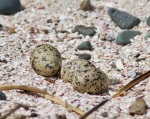An old nursery rhyme about an egg called Humpty Dumpty.
Humpty Dumpty sat on a wall
Humpty Dumpty had a great fall
All the king’s horses and all the kings men
Couldn’t put Humpty together again
The study of eggs is called oology.
Birds’ eggs come in different colours, sizes and shapes. Just as different species have different coloured feathers, birds have a variety of eggs too. They can be plain, coloured, spotted, freckled or splotched. A bird’s genes control the colour of their eggs. Egg colour comes from two pigments –
- Oocyan, which comes from bile and gives eggs their blue and green tints.
- Protoporphyrin, which comes from blood chemicals and causes the spots and patterns.
White eggs have no pigment.

Ground laying birds need well camoflaged eggs so their eggs have coloured spots and patterns to make them blend into their habitat.
Birds which lay their eggs in dark holes and burrows need to be able to see their eggs so they don’t get trampled. These eggs are usually a very pale colour, white or blue. Some eggs change colour while they are being incubated. They absorb colours from plants and nesting material.
The size of an egg tends to match the size of the bird which produced it. Small birds lay small eggs and bigger birds bigger ones. The kiwi lays the largest egg in proportion to its body size. It is six times bigger than the average bird’s egg. Based on egg size alone the ostrich produces the largest egg.
When the eggs hatch there are also differences in the chicks. Some chicks, for example all passeriformes (perching and song bird species), are born completely dependent on their parents for warmth, protection and food. This is called altrical. The chicks are blind, featherless and unable to move far. Their nests are usually well built and designed to give a helpless chick protection.
Other chicks such as quail, chicken and ducklings, are born ready to face the world. They hatch covered in down feathers, able to see and can leave the nest within two days. They may follow their parents or the first animal they see (called imprinting) but they can find their own food. This is called precocial. They may stay with their parents for some time or may start life completely independently of their parents, born with instinctive knowledge to survive and thrive.
Some chicks are born semi-altical. This chicks have down but cannot leave the nest and are fed by their parents. Some are born able to open their eyes and some are born blind. Hawk, heron and owls chicks are classified semi-altrical.
Gull and tern chicks are classified as semi-precocial. They can see, are covered in down and able to leave the nest soon after hatching. They can walk or swim however they stay at the nest and are fed by their parents.
Emperor penguins do not build nests, instead the female lays an egg and quickly moves it into her mate’s care. She then returns to the ocean to find food. The male penguin carries the egg on top of his feet and has a fold of skin called a brood patch, which covers the egg to keep it safe and warm in blizzard weather. He huddles with all the other male penguins to keep warm in one of the most extreme habitats in the world. He takes sole care of the egg for more than two months and does not eat anything during this time. Once the egg hatches the baby penguin is kept warm in the same fashion. The male regurgitates some liquid for the chick. The female returns to her mate around the same time as their egg hatches to feed the chick and take over child minding duties. The parents take turns traveling long distances to feed themselves then returning to relieve their partner.